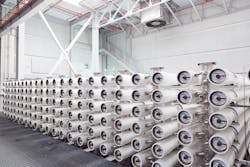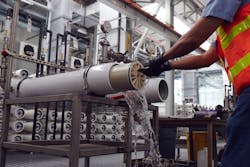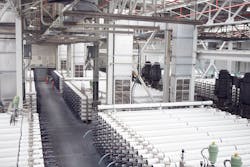One of the biggest threats facing humanity is water scarcity. And when it comes to defending the security of our most precious natural resource, few solutions are as promising as wastewater reclamation, a process that minimizes our dependence on freshwater. With proven results, accelerated adoption and improved public perception, more communities have begun to consider the treatment of municipal wastewater for reuse to help maintain adequate levels of clean water.
The trend toward water scarcity shows no signs of slowing as population levels increase, placing growing pressure on freshwater aquifers in the form of food production, industrial development and urban expansion. The situation is just as dire as it sounds, but there are glimmers of hope in the fight to secure a sustainable water future. After decades of research, development and innovation, reverse osmosis (RO) has emerged as an essential, affordable tool to help ensure access to potable water worldwide.
Compared to thermal systems, modern RO membranes are significantly more efficient and cost-effective at removing impurities. Membranes are also able to remove organic contaminants, which helps reduce dependence on chlorination. By enabling wastewater reuse, municipalities have a reliable and safe option to help mitigate water scarcity and provide clean drinking water to local residents.
As if dwindling water supplies weren’t bad enough, our freshwater aquifers face a secondary threat in the form of seawater intrusion. It has caused the salinity of coastal aquifers to increase over time. This only compounds the problem of water scarcity and makes large-scale adoption of wastewater reuse all the more urgent.
A State of Water Awareness
In California, water scarcity is hastened by a population that has grown with countless new residents flocking to the West Coast every year. It is a near-constant influx that has steadily depleted the region’s natural resources, along with cyclical drought conditions and more extreme weather patterns as a result of climate change. In fact, some might say that to live in California is to live in a state of constant water awareness. Much of the water in the state is used once and then simply let go, without recovering even half of it. This creates a constant tension between California’s residents and the state’s available water — there’s just not enough to go around.
There is at least one bright spot in California’s water picture, however. Orange County serves as a shining example of a community using wastewater reuse as a creative solution for preserving groundwater reserves and protecting aquifers from seawater intrusion. The Orange County Water District’s (OCWD) Groundwater Replenishment System (GWRS) relies on RO membrane technology to replenish natural freshwater barriers to saltwater intrusion and to provide much needed aquifer recharge with secondary treated effluent from local municipalities.
Water Scarcity Meets Its Match
OCWD has long been an innovative leader in recovering municipal secondary-treated effluent to create reusable, potable water. An integral component in the organization’s process is the GWRS, a 100 million gallon per day (MGD) advanced water purification facility that uses RO as the workhorse of its multiple barrier water treatment process.
To create potable water, the facility first employs microfiltration pretreatment to remove microorganisms and large, suspended particles. The water then goes through an advanced RO treatment system, removing dissolved chemicals, viruses and pharmaceuticals. Finally, advanced oxidation (UV and hydrogen peroxide treatment) disinfects the water. Most of the purified water then funnels to spreading basins to replenish groundwater aquifers, with the rest injected underground near the coast to protect the aquifer from seawater intrusion, and provide the county with an ongoing supply of highly purified drinking water that meets or exceeds all state and federal standards.
In recent years, OCWD recognized that Orange County could no longer depend on imported water sources, which are expensive and energy intensive. The team began expanding the GWRS, and by working with DuPont Water Solutions, they found a way to optimize wastewater reclamation.
The collaboration between DuPont and OCWD has led to a long-term strategy to further increase efficiency and productivity in the treatment of Orange County’s wastewater, utilizing advanced RO membrane technologies with higher permeability and fouling resistance. OCWD chose FilmTec™ Reverse Osmosis Elements for their RO system expansion.
Two-Fold Success
In facilities like the GWRS, the RO system can be an energy-intensive process. Adoption of advanced membranes, as seen with OCWD’s 30 MGD expansion in early 2015, lowered the energy required to treat the same amount of water by 13 percent when compared to the status quo performance of the existing membranes used in the original facility. Not only did reducing the energy it takes to purify wastewater translate into reduced operating costs, but it also lowered the carbon footprint of the plant.
Today, at full operation, the OCWD facility purifies more than 100 million gallons of treated wastewater a day to provide clean, high-quality drinking water for north and central Orange County. Through close collaboration, DuPont and OCWD research and development teams hope to create more technologies like these that can be implemented across the globe, making wastewater reuse an even more attainable reality for water-stressed communities.
Origin Story
Product innovation continues to improve the performance and economic viability of wastewater reuse to address myriad water issues in the public sector, all while minimizing harm to the environment. The treatment process continues to become more energy-efficient and cost-effective thanks to advancements in membrane chemistry, module and system design, and higher efficiency pumps and energy recovery devices. DuPont has made significant contributions to lowering total costs of RO by targeting advancements in productivity and lowering the overall energy intensity of its membranes. Over a decade ago, a seawater RO module could produce 4,800 gallons of water per day. Today, the same size unit can produce four times more volume. Southern California has benefited greatly from these advancements, offering hope to other communities around the globe facing their own diminishing resources.
Fateful Next Steps
The success story in Orange County is no doubt a huge win in the fight against water scarcity, but there is much more work to be done. Through trial testing, DuPont continues to improve membrane performance with higher sustained permeabilities, offering high-quality water at lower cost. There are serious global implications for these tests, as municipalities could one day use these technologies to secure a reliable local water source, reduce dependency on imported water, and replenish groundwater basins.
More regions will need to adopt a reuse approach similar to Orange County’s to cope with water scarcity. If a sustainable water future is to be achieved, global innovation in both technology, partnership and strategy will have to rise quickly and in tandem. New collaboration models between public utilities and the private sector will also play a critical role in the success of this paradigm. WW
About the Author: Steven Coker is the municipal technical leader with DuPont Water Solutions. He has 40 years of experience in the water treatment industry, with much of his career focusing on ion exchange and reverse osmosis applications in industrial and municipal markets.






